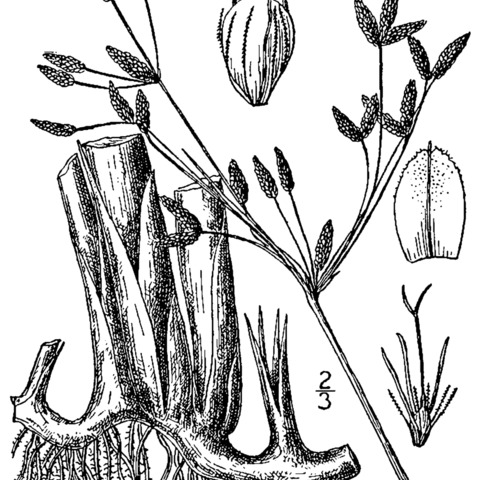Rhizomes 5–15 mm diam. Culms cylindric, 1–4 m × 2–10 mm. Leaves 3–4, all basal; sheaths often dark reddish proximally, front membranous-translucent and splitting, orifice adaxially deeply V-shaped; blades 1–2, C-shaped to dorsiventrally flat in cross section, usually much shorter than sheath, distal blade 8–120 × 3–7 mm, margins often scabridulous. Inflorescences 2(–3) times branched, open or compact, branches 6(–18) cm; proximal bract usually erect, thickly C-shaped in cross section, 1–9 cm, margins sometimes scabridulous. Spikelets 3–190, solitary or in clusters of 2–8, never all solitary; scales reddish to orange-brown to straw-colored, often variable on same scale, usually wholly or partly straw-colored and prominently lineolate-spotted at 10X, scale or midrib often green when young, ovate, 3–4 × 2–3 mm, sparsely to often densely reddish or straw-colored spinulose-papillose distally or on most of surface, margins ciliate, hairs long, contorted, flanks veinless, apex acute to obtuse, notch 0.3–0.5 mm deep, awn on at least some scales in spikelet usually strongly contorted, 0.5–2 mm (often broken off). Flowers: perianth members (4–)6(–8), brown, bristlelike, equaling achene body or sometimes much shorter, rarely rudimentary, spinulose; anthers 2 mm; styles 2(–3)-fid. Achenes dark gray-brown, plano-convex or rarely weakly trigonous, obovoid, (1.5–)2–3 ´ 1.2–1.7 mm; beak 0.2–0.4 mm.
More
A sedge. These grow in clumps and have grass like leaves and solid stalks. It keeps growing from year to year. It grows 1-3 m tall. It has a tough, thickened brown rhizome. The stems are unbranched and do not have leaves. The flowers grow near the tip of the stem. There are a cluster of heads. These are made up of overlapping scales. The fruit or seeds are hard and flat and 3-5 mm long.


